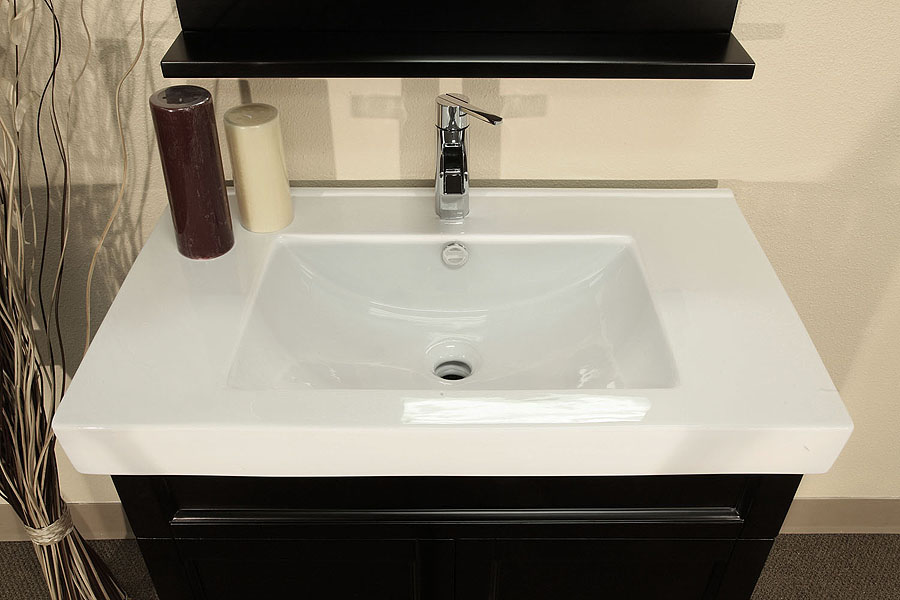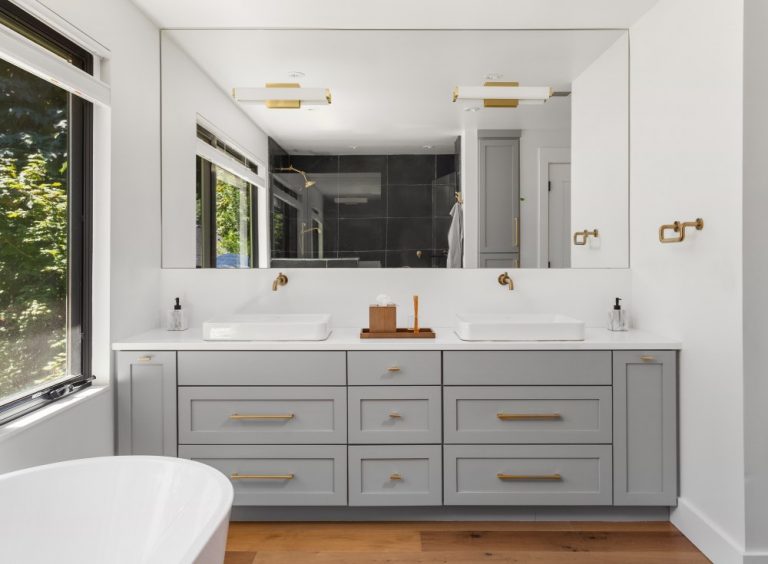Bathroom Vanity Design Considerations

A bathroom vanity without a backsplash offers a clean and minimalist aesthetic, but it’s crucial to consider its implications for functionality and maintenance. This design choice can impact water resistance, cleaning ease, and overall durability.
Bathroom Vanity Styles for Backsplash-Free Designs
A backsplash-free bathroom vanity can be seamlessly integrated into various design styles.
- Modern: Modern bathroom vanities often feature sleek lines, minimalist details, and a focus on functionality. A backsplash-free design can enhance this aesthetic by creating a clean and uncluttered look. Choose a vanity with a contemporary countertop material like quartz or porcelain, and incorporate geometric or linear elements in the design.
- Traditional: Traditional bathroom vanities typically embrace classic designs with ornate details and a sense of history. A backsplash-free design can work well in a traditional setting, especially if the vanity features a wood countertop or a classic pedestal base. Choose a vanity with a timeless design and complement it with vintage-inspired hardware.
- Minimalist: Minimalist bathroom vanities prioritize simplicity and functionality. A backsplash-free design perfectly complements this style, creating a serene and uncluttered space. Opt for a vanity with a clean, streamlined design and a countertop made of a simple, solid material like concrete or natural stone.
Material Choices for a Backsplash-Free Vanity, Bathroom vanity without backsplash
Selecting the right materials is essential for a bathroom vanity without a backsplash, as they will be exposed to moisture and potential splashes.
- Countertop Materials: Consider materials known for their durability, moisture resistance, and ease of cleaning.
- Quartz: A non-porous material that is highly resistant to scratches, stains, and moisture. It comes in a wide range of colors and patterns, making it a versatile option for any bathroom style.
- Porcelain: A durable and stain-resistant material that is also relatively affordable. Porcelain countertops are available in a variety of styles, including modern, traditional, and minimalist.
- Solid Surface: A non-porous material that is both durable and easy to clean. Solid surface countertops are available in a wide range of colors and patterns, and they can be seamlessly integrated into a backsplash-free design.
- Vanity Base: Choose a vanity base made of a water-resistant material, such as:
- Wood: Select hardwoods like oak, maple, or cherry, which are known for their durability and water resistance. Make sure the wood is properly sealed and finished to protect it from moisture.
- Laminate: A cost-effective and durable option that is available in a variety of colors and finishes. Laminate vanities are typically moisture-resistant and easy to clean.
- Acrylic: A smooth and non-porous material that is highly resistant to water and stains. Acrylic vanities are also lightweight and easy to maintain.
Designing a Backsplash-Free Bathroom Vanity
For a bathroom vanity without a backsplash, consider a countertop material like quartz. Its durability, moisture resistance, and ease of cleaning make it an excellent choice for a high-traffic area like a bathroom.
- Countertop Design: Choose a quartz countertop with a sleek, minimalist design to complement the backsplash-free aesthetic. Consider a solid color or a subtle pattern to create a clean and sophisticated look.
- Vanity Base: Opt for a modern, freestanding vanity base with a simple, geometric design. This will create a sense of openness and enhance the minimalist feel of the space.
- Hardware: Select minimalist hardware in a brushed nickel or chrome finish to complete the modern look. Avoid ornate or decorative hardware that might detract from the clean lines of the design.
Alternatives to Backsplash

A backsplash isn’t the only way to protect the wall behind your bathroom vanity. Several alternative materials offer protection and aesthetic appeal. These options can be more cost-effective, easier to install, and better suited to specific bathroom designs.
Waterproof Paint
Waterproof paint is a cost-effective and easy-to-apply solution for protecting the wall behind a bathroom vanity. It creates a smooth, seamless finish that is resistant to moisture and stains.
Advantages
- Cost-effective: Waterproof paint is generally less expensive than tile or decorative panels.
- Easy application: It can be applied by a homeowner with basic DIY skills.
- Seamless finish: Waterproof paint creates a smooth, continuous surface that is easy to clean.
Disadvantages
- Durability: Waterproof paint may not be as durable as tile or decorative panels and may require repainting over time.
- Limited aesthetic options: Waterproof paint comes in a limited range of colors and finishes.
Tile
Tile is a popular choice for bathroom walls because it is durable, waterproof, and easy to clean. It comes in a wide variety of colors, patterns, and textures, offering a wide range of aesthetic options.
Advantages
- Durability: Tile is highly resistant to moisture, stains, and scratches.
- Versatility: Tile comes in a wide range of colors, patterns, and textures, allowing for customization and design flexibility.
- Easy maintenance: Tile is easy to clean and maintain, making it a practical choice for bathrooms.
Disadvantages
- Cost: Tile can be more expensive than waterproof paint or decorative panels.
- Installation: Installing tile requires specialized skills and tools, making it a more complex project.
Decorative Panels
Decorative panels are a modern alternative to traditional backsplashes. They come in a variety of materials, including wood, metal, and plastic, and offer a range of styles and finishes.
Advantages
- Style: Decorative panels can add a unique and stylish touch to your bathroom.
- Ease of installation: Many decorative panels are designed for easy installation, often requiring only adhesive or clips.
- Variety: Decorative panels come in a wide range of materials, colors, and patterns.
Disadvantages
- Cost: Decorative panels can be more expensive than waterproof paint or tile.
- Durability: Some decorative panels may not be as durable as tile, especially those made from wood or plastic.
Bathroom Vanity Without Backsplash

Embracing a minimalist aesthetic, bathroom vanities without backsplashes offer a clean and modern look. This approach not only creates a sense of spaciousness but also allows you to showcase the beauty of your bathroom walls, whether it’s a unique tile pattern, a bold paint color, or even a textured wallpaper.
Bathroom Vanity Designs Without Backsplashes
Vanities without backsplashes can be designed in various styles, materials, and color palettes to suit different tastes and preferences. Here are some examples:
- Modern Minimalist: A sleek, white vanity with clean lines and simple hardware, paired with a gray or white wall, creates a contemporary and airy feel.
- Industrial Chic: A reclaimed wood vanity with metal accents, set against exposed brick walls, adds a rustic and industrial touch to the bathroom.
- Rustic Elegance: A vanity crafted from natural stone, such as marble or granite, with a warm wood countertop, complements a neutral-toned wall with subtle texture.
- Bohemian Charm: A colorful vanity with intricate carvings or a unique finish, placed against a patterned wallpaper or a vibrant wall paint, adds a touch of bohemian flair.
Incorporating Decorative Elements
Even without a backsplash, you can still enhance the visual appeal of your bathroom vanity with decorative elements.
- Mirrors: A large, statement mirror above the vanity can reflect light and create an illusion of more space. Consider a mirror with an interesting frame or a unique shape for added visual interest.
- Lighting: Well-placed lighting can highlight the vanity and its features. Sconces on either side of the mirror, or a pendant light above the vanity, can provide both functional and decorative illumination.
- Storage Solutions: Open shelves, baskets, or drawers can be used to organize toiletries and other bathroom essentials while adding a touch of visual interest. Choose storage solutions that complement the style of your vanity and the overall bathroom design.
Inspirational Images
Imagine a bathroom with a floating vanity crafted from reclaimed wood, featuring a sleek, white countertop and a large, round mirror with a brushed nickel frame. The vanity sits against a wall painted in a deep, calming blue, creating a striking contrast. The lighting is provided by two wall-mounted sconces with frosted glass shades, casting a warm and inviting glow. This design combines industrial chic with modern minimalism, showcasing the beauty of a backsplash-free approach.
Another inspiring example features a freestanding vanity made from polished concrete, with a natural wood countertop and a large, rectangular mirror with a minimalist frame. The vanity is placed against a wall covered in small, white subway tiles, creating a clean and modern backdrop. The lighting is provided by a single pendant light above the vanity, adding a touch of elegance. This design emphasizes the versatility of concrete and its ability to create a contemporary and sophisticated bathroom space.
Designing a Bathroom Vanity Without Backsplash
When designing a bathroom vanity without a backsplash, it’s crucial to consider both functionality and aesthetics. Here are some tips for creating a stylish and practical design:
- Choose a vanity with integrated storage: Look for a vanity with drawers, shelves, or cabinets to keep toiletries and other bathroom essentials organized.
- Incorporate a countertop with a built-in sink: This eliminates the need for a separate sink basin and creates a seamless look.
- Add decorative accents: A beautiful mirror, elegant lighting, and stylish storage solutions can enhance the visual appeal of your vanity.
- Consider the overall bathroom design: Ensure the vanity complements the style and color scheme of your bathroom.
Bathroom vanity without backsplash – Okay, so you’re thinking about ditching the backsplash on your bathroom vanity, right? It’s totally a chic look, but make sure your vent is in tip-top shape. You wouldn’t want to deal with a leaky vent, especially during monsoon season! Check out this article bathroom vent leaking when it rains for some tips on how to keep things dry.
Once you’ve got your vent sorted, go ahead and rock that minimalist vanity look!
Okay, so you’re thinking about a bathroom vanity without a backsplash? Super chic, right? But remember, even the most stylish vanity can’t hide those pesky brown spots on your ceiling. If you’re seeing those, you might want to check out this article on brown spots on bathroom ceilings to figure out what’s going on.
Once you’ve sorted that out, your vanity will look even more fabulous without the distraction of those pesky spots.